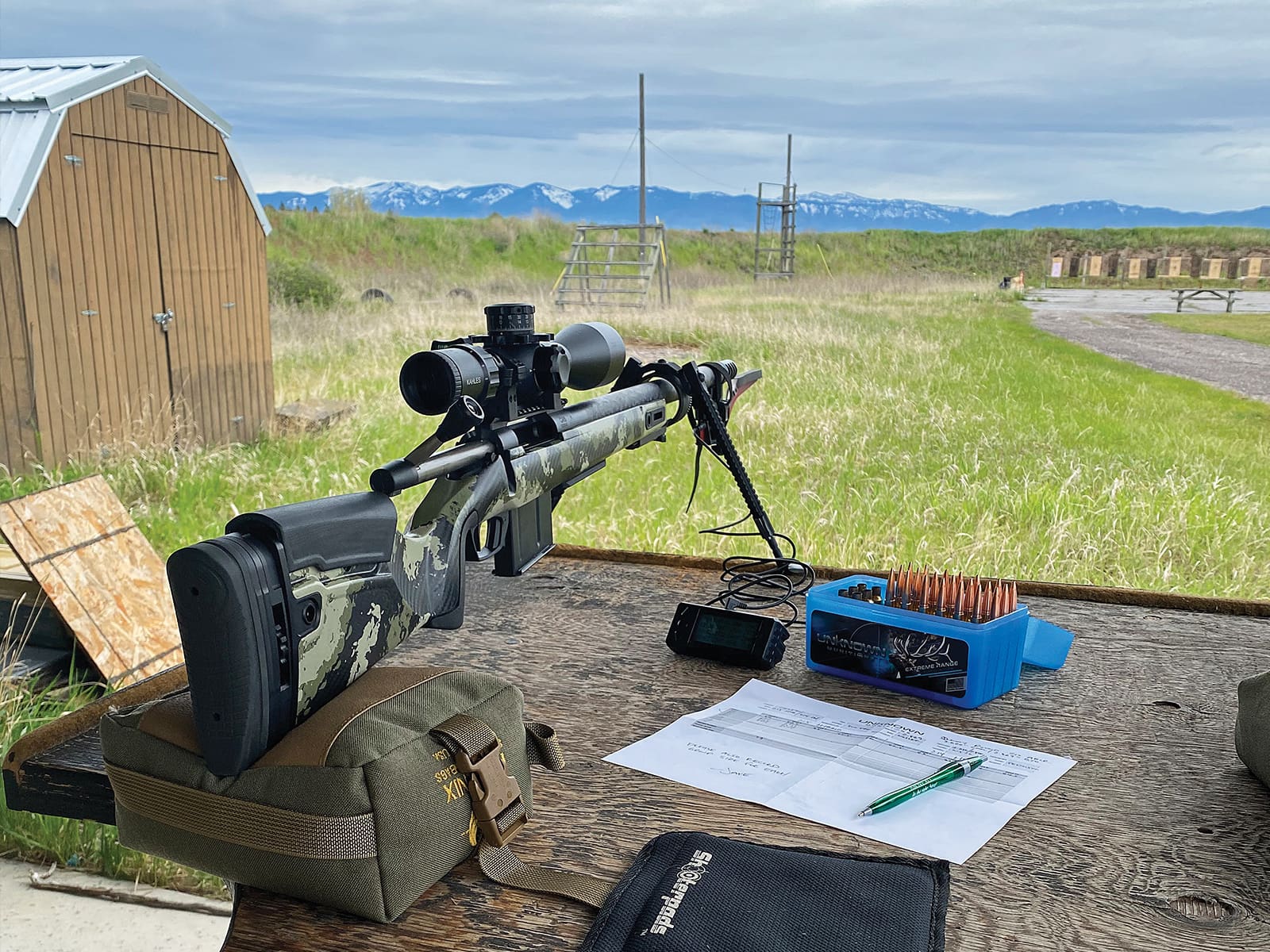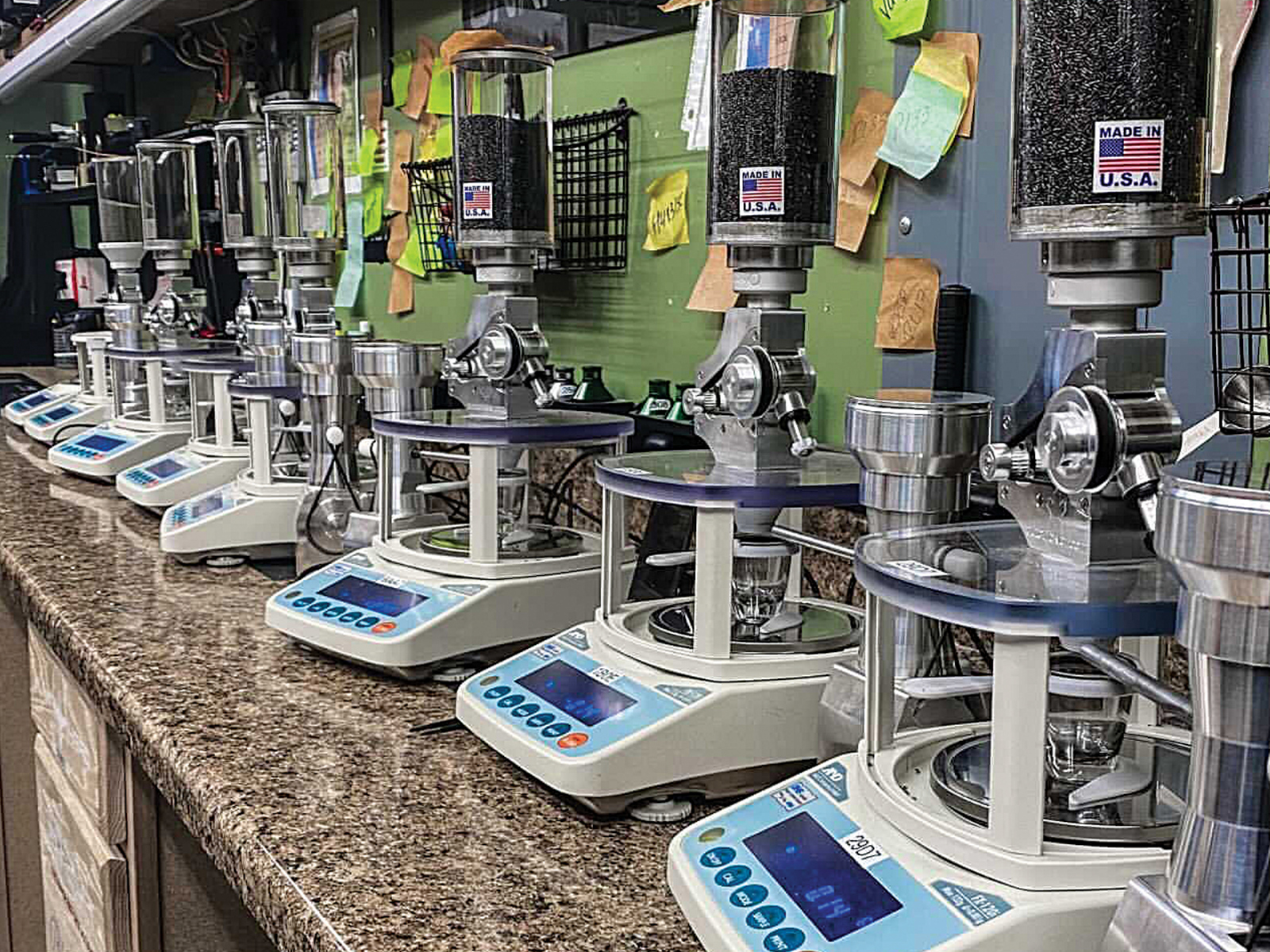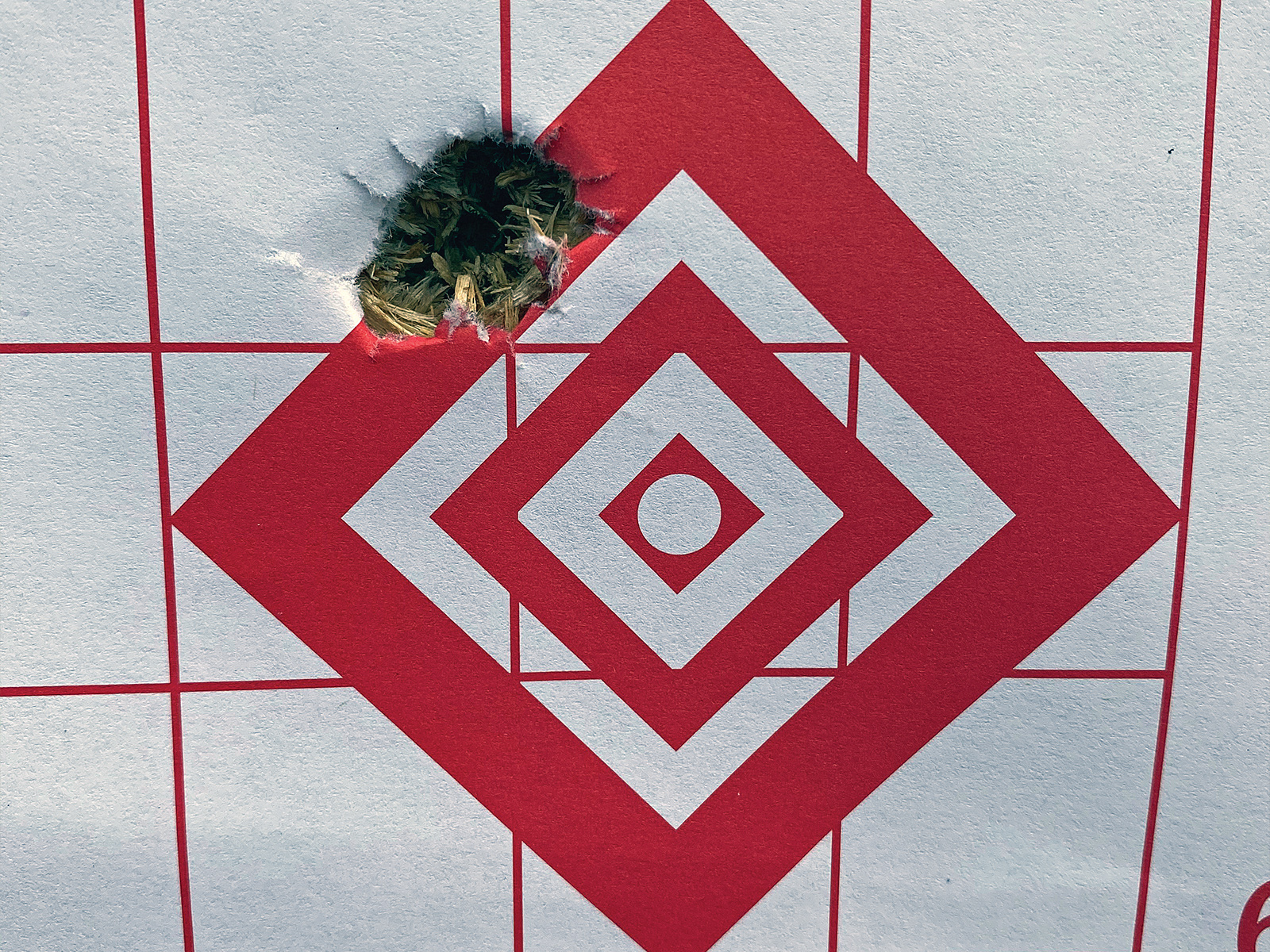
NOTICE: Certain links on this post may earn a commission for Western Hunter Magazine from Amazon or our other affiliate partners when you make a purchase. Thank you for your support.
Building a Cartridge
The clay pigeon was set up on a distant dirt bank, 1,086 yd to be exact, with the wind blowing 4 mph left-to-right and slightly rising up the mountainside. I had 7.8 mils dialed on my turret as I held .3 mils left for wind. The shot was executed and through recoil I could see the 215-grain Berger arc above the target and drop in perfectly, causing the orange clay target to disappear from view. That view never gets old. The road traveled to get this sense of accomplishment can be a rough one for many when it comes to developing a load for your long-range rifle.
While we have great factory ammunition available today, many shooters are finding value in custom-loaded ammo and getting more accuracy or, in my case, a wider variety of bullets not offered in factory ammunition. While handloading is a fun and rewarding hobby, the constant hunt for components can become exhausting, and making time to meticulously sort and prep brass can be difficult to balance. With time being the most precious commodity, many are looking for an easier way.
Before the above-mentioned scenario could take place, I had burned 250 rounds through my 30 Nosler barrel, trying a variety of bullets and powder that would work best and getting results that were less than satisfactory at distance. The bullet I wanted to use was not available in factory ammo, leaving me no choice but to hand-load. I was about to settle on a recipe when I came across the Unknown Munitions page on Instagram. I decided I would take advantage of their enormous selection of powder and bullet offerings.
The Real Deal
I did the math and figured even after I paid for their load development service, I’d still be ahead in the cost of powder, bullets, and primers. Factor in time loading ammo, driving to the range, not to mention added barrel wear, and I’d be way ahead. I made a phone call to speak with Jake, the owner and central operations manager, and I was blown away by his extensive knowledge of all things reloading.

After our conversation revolving around all things Elk hunting and 30 caliber rifles, I decided to send 100 pieces of new Nosler brass for my Gunwerks 30 Nosler, the above-mentioned rifle, and have them work their magic. We agreed to start with a load development package utilizing Berger 215-grain VLDs and Vitavouri N570 powder. Jake has extensive knowledge of what combinations of bullets and powders work best based on the intended application. He was very informative and quickly built my confidence in his abilities.
Anyone that reloads can speak to the massive amount of gun powder one can go through to find the perfect load for their rifle. I have countless partial one-pound powder canisters that I have accumulated over the years of trying this and that–only to go through six different powders to find the right charge. At $35-40 per pound, the stuff ain’t cheap! I got to thinking about how much powder I had burned trying to chase the node or “sweet spot” in all my barrels over the years. After adding it up, I realized that it had cost me way more money in powder for each rifle load development than to purchase a load development kit from Unknown Munitions.
The Process
The first package would include 25 rounds of my supplied brass to be loaded with a powder charge ladder test to find the right node in the barrel where the muzzle velocity is the most consistent–therefore the most accurate charge for that bullet combination with my barrel. Unknown Munitions starts all load development with brand-new, unfired brass to ensure that the brass has consistent elasticity in the area of neck tension and is unaltered by previous firings or resizing dies.
If your brass has numerous firings, it may have a varying range of tension on the bearing surface of the bullet, this can lead to a large deviation in your Muzzle Velocity (MV). It’s pretty simple; one piece of brass holds the bullet too tightly, the other not enough... you get the picture. When starting with load development (LD), it helps to remove as many factors as possible. Always start with fresh, new brass. Unknown Munitions stocks a large amount of high-end brass for almost every common caliber and will load just about any cartridge.

All of their brass is hand-primed using Primal Rights CPS and Dillon Precision RF100 priming tools. These tools allow the cases to be primed efficiently and accurately. During every step of the loading process, Unknown Munitions staff wears gloves to reduce contamination of the primers or powder with oil from their hands. I know I have never done this, but it makes sense and is a respected practice! When it comes to primers, Unknown Munitions has them all and will gladly point you in the right direction based on your ammunition needs. For my test, I went with the tried-and-true Federal 215M as I have great success with them and have plenty to last a while. No, they are not for sale.
Once the brass casings are primed and ready, they get charged with the selected powder for your LD Test. Unknown Munitions uses only FX120i Lab Scales and auto-thrower systems to measure each charge. These lab scales have become the gold standard for precision reloading. I had recently purchased one of these scales and compared it to my Hornady and RCBS Powder throwers and was astonished by how much the charges varied between these two factory scales which are widely used today. Each charge is measured to .01 of a grain with the FX120i, while most reloading scales stop at .10 of a grain. This is a huge difference. The FX120i is my scale of choice for reloading. The cost of these scales is over $1,000 to set up and Unknown Munitions runs eight of these units to keep up with orders! This shows their commitment to delivering the highest-quality product to their customer.
Once primed and charged, the cases are ready to be seated with the selected bullets to the COAL (Cartridge Overall Length) utilizing premium dies from Redding and Foster. Unknown Munitions recommended the use of a Hornady COAL gauge to accurately measure COAL for the intended bullet’s contact with the lands of your individual chamber. You can purchase or rent the tool from Unknown Munitions, and they offer a modified case service to get you any brass and bullet combination you may need for your Hornady COAL gauge. It is a simple process that requires you to thread a modified case onto the tool, then place a bullet inside the case mouth.
Finding Your COAL
First, run the case into your chamber as if chambering a round with the tool. Loosen the thumb wheel on the back of the tool and slide the internal rod forward until you meet slight resistance. The resistance is the bullet being pushed forward into the barrel lands. Tighten the thumb wheel and carefully remove the tool. Place the bullet back into the case mouth if it has fallen out during removal and measure the overall length of the round. You now have your COAL for your chamber. It is that easy and it takes five minutes. Once Unknown Munitions receives your COAL they will begin loading up your testing ammunition and ship it directly to your doorstep. They also offer a full rifle development service for those who prefer their expertise. Simply ship your rifle to Unknown Munitions and have them do all of the necessary testing, and they will ship your rifle back with the developed ammunition.
Main Factors in LD
A big part of the initial load development process is getting an accurate read of your MV (muzzle velocity), speed of your bullet exiting the muzzle, SD (standard deviation), a measure of the uniformity in velocity, and the ES (extreme spread), a measure of the highest muzzle velocity minus the lowest velocity. Typically, it takes a minimum of five shots to achieve an accurate SD and ES. For example, if you fire five rounds with an MV of 2850, 2860, 2855, 2857, and 2855, your ES will be 10 and your SD will be 3.3. There are lots of opinions on what matters more, ES or SD, but ultimately if you lower the ES of your shot string, the SD will typically be smaller. These factors are an accumulated average of how well your charge is measured and how consistent you can keep the neck tension on your case. This information gathered in the first step of the LD process will help determine what charge is best for your barrel and bullet combination.
When gathering the MV for the LD it is critical an accurate chronograph is used for the testing. Unknown Munitions recommends the MagnetoSpeed Chronograph for its simple design and ease of use. They also offer a rental service for those without access to a chronograph. I personally use the MagnetoSpeed chronograph and can attest to its simple design and accurate data collection. For my range day test, I started with five sighter/fouler rounds through a clean bore.
I continued after I zeroed with the lowest charge of rounds and worked my way through the first two charges before allowing the barrel to cool. Between every five rounds, I documented each MV, ES, and SD for each charge on the datasheet provided by Unknown Munitions. I continued the process, working through all the charges and letting the barrel cool after every 10 rounds. After all the data was gathered, I pulled my targets, measured all my groups, and documented which group went with which charge. This is an important part of the process, so take your time and ensure that you document things accurately.
Load Testing
After the initial range day collecting charge data, I sent the information back to Unknown Munitions via email and waited for the next lot of 25 rounds to arrive for seating depth testing. At this point, we find how much jump the bullet prefers in our chamber. Typically starting at .010”, .020”, .030”, .040” .050”, .075”, and .100” of the COAL of the chamber. During this test, I shot one round from each seating depth in a “round-robin” order on individual targets and let the barrel cool for 10 minutes after one round had been fired from each seating depth. This process helps spread out the heating and fouling of the barrel more evenly throughout the test as opposed to shooting each ladder in order. It also helps keep my focus on pressing each shot individually and not worrying about how well everything is grouping when I shoot five rounds at the same spot for a group.
After measuring the final seating test targets, I sent the data back to Unknown Munitions one final time. The average group measured .65” and the best group was .39” at 100 yd. With an ES of 3 and SD of 1.7, we had found the best load for my rifle with 50 rounds in two range days. I had the remaining 50 pieces of brass loaded with the best charge and seating depth from our test. These 50 rounds proved to be the most accurate loads fired from this rifle, ensuring we had established a solid recipe through the Unknown Munitions LD process. After establishing solid data between 100-1,000 yd, I was able to send the last five shots downrange inside a 6” group at 1,100 yd. For many, that seems like an unobtainable goal, but for the crew at Unknown Munitions, it is just another representation of their commitment to leading the ammunition industry to the next level.

Whether you’re looking to shoot a bullet that is unavailable in factory ammo, seeking better performance from your rifle, or tracking down accurate load data for a new rifle without spending a week’s pay on components, Unknown Munitions has you covered. Even with the ammunition and component shortage at the time of this article’s writing, the crew at Unknown is receiving powder, brass, primers, and bullets on regular basis and can load a variety of ammunition needs. They have a waiting list running for loaded ammunition as well as their load development services, so get signed up. While you’re waiting, check out their full lineup of ammunition for your next range day. From here on out, I know this is where I will be sourcing my ammunition and load development needs. For more information on available ammunition and load development services visit unknownmunitions.com
As always, help keep the gun conversation alive by contacting me at colton@westernhunter.net with your questions or suggestions for future product reviews. Follow me on Instagram @papwinkle to see my online posts and reviews on all things precision rifle to make you a better rifleman.

